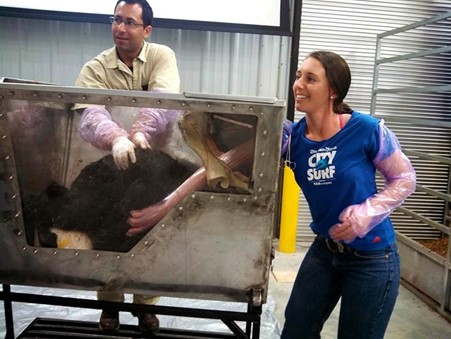2013 – Georgina Lawrence


As a recipient of the inaugural Semex Genetics Angus Youth Kansas State University Scholarship, I left for the United States in January this year. I arrived in Los Angeles and flew to Denver, Colorado, where I attended the National Western Stock Show. This was a great opportunity to see some of the best livestock in the nation on show and to see how cattle are prepared and shown in such extreme cold conditions.
I then made my way to the center, to Manhattan, Kansas, where I spent 4 months studying during the spring semester at Kansas State University. I took ruminant nutrition, beef science, cow-calf health, livestock sales management and beef systems management classes. As part of these classes, we visited a seed stock, stocker or feedlot operation throughout the state each week. This included touring National Beef Packing Company, a meat processing facility in Dodge City, KS. This was a great insight for me to get to know how the industry works in Kansas and in the US.
As part of the livestock sales management class, my fellow students and I assisted with the annual KSU Legacy Bull and Female Sale, giving us experience in preparing and running a sale. We also had guest speakers from different areas of the beef industry come and present to us in various classes. This gave me an opportunity to meet leaders in the industry from a range of disciplines.
Mid way through the semester, I went on Spring Break to the Sandhill Farms Ranch where I got first-hand experience learning how the Americans farm their land and run cattle as well as helping them with preparation for their on-farm annual sale.
I was in a variety of classes, which gave me the chance to meet many fellow students in the College of Agriculture at KSU. I was also fortunate enough to travel with the KSU Collegiate Cattlewomen and Cattlemen to Nashville, Tennessee, to attend the annual beef convention hosted by the National Cattlemen’s Beef Association.
Arriving in January, I saw one of the coldest months of the year, waking up to inches of snow and walking to classes in -20°C. This was a great challenge for me in itself but the American’s don’t let it get in their way. Cattle are brought in close to feed supplies on the ranches in the winter where they calve out cows in barns and then in the warmer months cattle are taken to pasture. Angus and Angus cross cattle were a common sight in Kansas, although cattle come from all over the country to be fed in feedlots close to grain supplies and meat processing facilities. I noticed that cattle entering the feedlots were generally younger than their Australian counterparts. In the time that I was over there, the national cattle inventory was the lowest since the 1950’s due to drought. It was anticipated that producers would start retaining females to rebuild their herds, in turn tightening beef supplies.
I would like to thank Angus Youth, Semex Genetics and Kansas State University for their efforts to allow me to learn and experience the American beef industry first hand. I am grateful to have learned so much at a fantastic agricultural university and to have made friends for life in America who share the same passion for agriculture as I do.
Georgie Lawrence
K-State Scholarship Recipient 2013